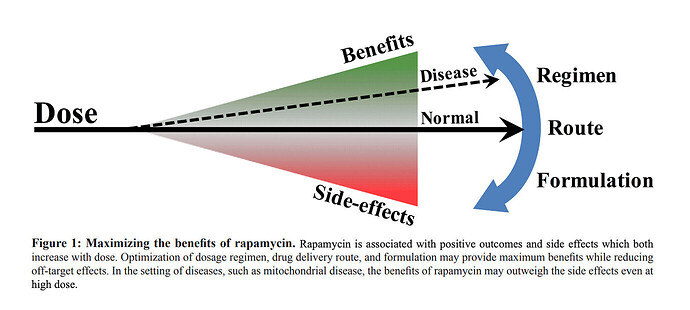Hmmm…I’m haven’t actually bought into this “we shouldn’t shut off mTOR” thinking, it’s just conjecture, and I think related to some acute TOR inhibition experiments, not at all relevant for translation.
Why does anyone think we are shutting off mTOR in humans with constant, high as tolerable pittance weekly dosing? Where is the tissue mTOR DATA? Are people falling like flies, completely immobilized?
In pretty much all the rapamycin/rodent studies, they were giving these mice massive daily doses, regardless of the intervention duration. Mice had very high blood levels of rapamycin, and these were happy go lucky mice. Yet when they went to look at the various tissues for mTOR inhibition…what did they find? ONLY PARTIAL MTOR INHIBITION. Yes, severe acute mTOR inhibition is detrimental, but that is such an extreme regime, not used in typical rodent longevity practice, just longevity model end posts.
So in translating to humans for longevity…show me where it’s proven that the highest dosing tolerable completely shuts down mTOR such that it actually impacts healthspan (putting aside the side effects)?
Galvan, in her seminal cognitive study on rapamycin/WILD type mice, showed that hippocampal brain tissue showed only 30% mTOR reduction, and NO mTOR2 reduction at all. Yet, these rapamycin treated mice showed far superior cognitive ability in older age vs. control? So I am to accept that the pittance of dosing we are taking is going to ABOLISH mTOR1, and I’m all of a sudden going to stop breathing and collapse or shrink in size?
Chronic inhibition of mTOR by rapamycin modulates cognitive and non-cognitive components of behavior throughout lifespan in mice
"Our studies show that feeding encapsulated rapamycin in chow at 14 ppm for at least 16 weeks is sufficient to improve cognitive outcomes in both adult (8 month-old) and in old (25 month-old) C57BL/6 mice compared to control-fed littermates. Rapamycin concentration in the chow results in an average dose of 2.24 mg rapamycin per kg body weight/day. To determine whether rapamycin treatment inhibited mTOR in brain, we examined the phosphorylation status of the mTORC1 targets p70 S6 kinase (p70) in brains of control- and rapamycin-fed mice.
Our results suggest that an approximate 30% reduction in TOR activity in brain for 16 weeks or longer improves performance of C57BL/6 mice in tasks that involve long-term plasticity and are dependent on hippocampus or on hippocampus and prefrontal cortex chronically decreased TOR activity (in our studies, approximately 30%) can improve learning and retention of a spatial task in young mice and improve memory of an aversive event in old animals.
Thus, it is conceivable that long-term, partial reduction of mTOR activity by rapamycin administered in the chow mimics the effect of calorie restriction, enhancing cognitive outcomes in young mice and maintaining intact cognitive performance in older animals.
Of note, cognitive effects of rapamycin feeding were observed when mice were fed for 16 weeks or as long as 40 weeks, suggesting that the effect of chronic rapamycin treatment is sustained for protracted lengths of time. We observed no differences in the phosphorylation of mTORC2 targets in whole brain and in hippocampi of mice treated chronically with rapamycin"”
Only 30% brain mTOR reduction at massive doses? Sure, our metabolism is far slower than mice, there’s a huge translation gap…but I don’t think we have even come close to triggering significant mTOR inhibition.
We are at the castle walls trying to get in, but the moat (side effects) is blocking our entry. We need to find a way to get more Rapamycin into the cells/brain and bypass the liver (side effects) to try and scale the walls!
